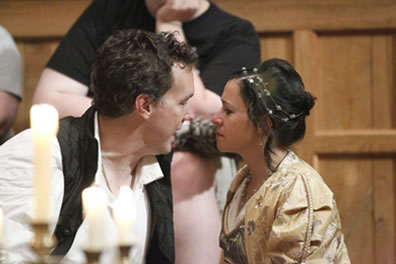Hamlet
The Clown Prince of Denmark
American Shakespeare Center, Blackfriars Playhouse, Staunton, Va.,
Saturday, August 13, 2011, D–5&6 (middle stalls)
Directed by Jim Warren
As the applause finally died down after the fourth curtain call, my wife, Sarah, turned to me and said, “Now, that was a Hamlet I enjoyed.” In particular, it was Hamlet himself that she enjoyed; rather than a sour, dour, morose, obtuse, naval-gazing Hamlet, this prince was cunning, cynical, devious, sarcastic, and very much enjoying his feigned madness, his chess game with the king, and his fencing bout with Laertes.

With members of the audience sitting on the gallants' stools in the background, John Harrell as Hamlet and Miriam Donald as Ophelia play out their testy moment at the beginning of The Mousetrap scene. Photo by Tommy Thompson, American Shakespeare Center.
That is the kind of interpretation we would expect from John Harrell, one of the ASC’s most gifted comic actors who has earned a reputation for playing cunning characters engaged in chameleonic strategies. We also expected, and got, a lot of laughs in this Hamlet. That was only partly due to Harrell’s delivery of Hamlet’s wit. Shakespeare’s sense of humor never abated even when he was writing the most nihilistic of tragedies (i.e., King Lear), and Hamlet is full of quips and comic characters.
Director Jim Warren and this troupe gleaned much of this humor out of the text, some in unexpected, but perfectly suited, places. The first laugh came at the expense of Horatio (Patrick Midgley), who pooh-poohed the guards’ account of the ghost asserting it was “but [their] fantasy.” After Horatio saw the ghost himself, Bernardo (Allison Glenzer) broke the dramatic tension by rounding on him: “How now, Horatio? You tremble and look pale.” And with a wag of her head, “Is not this something more than fantasy?” The two guards also grew testy as Horatio hogged the subsequent interview with Hamlet about the ghost.
Though the production provided laughs aplenty, this was not a comedy. Even Rosencrantz (Glenzer, again) and Guildenstern (Daniel Burrows), who played for laughs in their early scenes, seethed with danger after the Mousetrap. Polonius (Benjamin Curns) had his funny moments, of course, wandering off into tangents, but he was no buffoon. He was a king’s advisor trying to do his job and keep his family safe, totally unaware of the dangerous mischief that set this play in motion.
Meanwhile, Horatio took a strange course through the play. After the Mousetrap, he was Hamlet’s comic sidekick, playing off the prince’s jokes in the encounter with Rosencrantz and Guildenstern. But upon Hamlet’s return from England, the prince now viewed Horatio with a degree of distrust, while Midgely’s Horatio navigated through his now uncertain relationship with Hamlet and showed some degree of horror seeing Hamlet’s pleasure retelling how he turned the tables on Rosencrantz and Guildenstern.
To be clear, Hamlet was not a comic character, per se, in this production. Harrell’s Hamlet was a man with a sharp sense of humor, and he spared no one his barbs, even Horatio. But in his soliloquies, he waged a sincerely felt conflict pitting his nature against needs, the world as he’d like it, and the world that was. A student of Shakespearean text, Harrell gave fresh readings to all of his soliloquies, including the most famous one. He entered and rushed right in to “To be or not to be,” a typical actor’s tact to get on with the speech everybody’s waiting for. But with “perchance to dream, aye” he paused. Holding up his finger he noted, “There’s the rub,” and the remainder became the real meat of the speech.
Behind him stood Ophelia, and she reached out to him at this point, but he stepped forward to continue the soliloquy. Miriam Donald proved in her portrayal that Ophelia is not the throwaway character I’ve always considered her. Donald’s Ophelia was a strong, young woman in the tradition of Viola and Rosalind. She was fervent with her father concerning Hamlet’s courtship, genuinely frightened by Hamlet’s behavior in the closet scene, and by that tender reaching out in the “To be” soliloquy she showed how much she cared for Hamlet. But what followed was the nunnery scene, and this Ophelia stood up stoutly against the railing man. Only after he left the stage did Ophelia shed real tears and gave a resigned reading of those lines where she recognized that what once was her Prince Charming was irretrievably lost: “O, what a noble mind is here o’erthrown.” Thus, in the Moustrap scene, Ophelia remained guarded when Hamlet started playing with her again. In the mad scenes, Donald kept a subdued demeanor—still a strong-minded young woman, only that mind was completely distracted.
Another unusually tender moment came with the Ghost in Act 1. René Thornton Jr. is one of the company’s great speech-makers, perfect for the cadenced conversation Hamlet’s Ghost has with his son. But when he described how his sudden death led to his state of purgatory, rather than roaring forth his “O horrible, O horrible, most horrible!” Thornton went soft and gazed out over the kneeling Hamlet’s head in a pained expression, the horrors so terrible he could hardly speak of them. Then, the Ghost reached out and stroked his son’s hair, and Hamlet clasped the Ghost’s hand. How the specter became corporeal at that point is open to debate, perhaps, but it was a touching moment emotionally as well as physically, showing genuine love between father and son, and on that basis the prince proceeded with his revenge plot.
It was remarkable how different this production of Hamlet was from the ASC Touring Troupe’s version two years before, both directed by Warren. That’s the beauty of this play. It offers so much. Even in this single telling, it offered so much.
Eric Minton
August 15, 2011
Comment: e-mail editorial@shakespeareances.com
Start a discussion in the Bardroom



 Find additional Shakespeareances
Find additional Shakespeareances